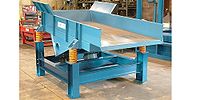Twin Motor Feeders
Twin motor feeders convey product by utilizing two counter rotating rotary electric drives. Because the motors counter rotate, lateral forces are canceled out and linear forces are combined, providing quiet and positive conveyance action. This method requires no belts, crank arms, rocker arms or leaf springs which leads to minimum downtime. The synchronized motors provide a semi-balanced design, eliminating uncontrolled bouncing during shutdown. Twin motor feeders' heavy-duty construction and durable components are ideal for many industries and applications.
Applications
- Dry bulk material handling
- Metal recycling
- Glass recycling
- Waste recycling
- Mining
- Aggregates
- Wood
Benefits
- Heavy-duty construction
- Capacities ranging from 60-3,500 TPH
- Base mounted or suspension mounted isolation
- Customized design
- Low maintenance
- Quiet operation
Twin motor drive feeder and conveyor units are ideal for high capacity feeding and conveying applications where the throughput rate is fixed or infrequent adjustment is required. They are used in many industries, such as, steel making, mining, quarrying, foundries, food processing and chemical industry for the feeding and transfer of bulk materials. Unlike other systems, they are simple to install and do not require skilled tuning on site. Although the maximum single unit length is 6m, multiple units can be mounted in series with minimal or no height loss to achieve greater conveying lengths.
The main construction consists of a weld fabricated conveying trough, which can be supplied as a trapezoidal, rectangular or tubular assembly, and drive assembly onto which the vibrator motors are mounted. The drives and drive assembly can be mounted below or above the trough. The trough and associated structure are normally manufactured from carbon steel, stainless steel or a combination of both. These materials are adequate for the majority of applications, but the conveying troughs can also be manufactured from other materials, such as abrasion resistant steel, polypropylene, etc. Also, liners and coatings can be incorporated into the hough to help eliminate or minimize various problems, such as: expendable liners for highly abrasive applications; flexible liners for light products that have a tendency to adhere or compact; energy absorption liners like laminated steel and rubber, polypropylene, rubber and polyurethane which minimize noise generation caused by the impacting of the product on the trough during conveying.
Tubular feeders and conveyors are particularly suitable for applications where dust emissions, atmospheric pollution or product contamination are to be prevented. The conveying tubes are crevice free and can be fitted with either bolted or quick release dust tight end plates. Bolted or quick release dust tight covers can also be fitted to trapezoidal or rectangular section troughs on which both the inlet cover and the outlet of the conveying trough can be fitted with either discharge spigots or bolting flanges for flexible sleeves. All the equipment can be manufactured in accordance with the hygienic and legislative requirements of the food and pharmaceutical industries. A range of equipment finishes are available for both product contact and non contact surfaces which include spraying, powder coating, polishing and bead blasting.
Video
